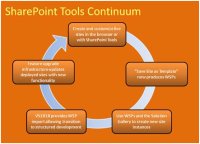In-Depth
Four Use Cases For SharePoint 2010 Development
Vishwas Lele is chief technology officer of Applied Information Services and a Microsoft Regional Director. He offers four use cases that make SharePoint 2010 a compelling target for application development.
We recently spoke with Vishwas Lele, a veteran SharePoint developer who is chief technology officer of consultancy Applied Information Services (AIS) and a Microsoft Regional Director. You can
read our Q&A with Lele here. He also offered us insight into four use cases that make SharePoint 2010 a compelling target for application development, sharing this excerpt from an AIS-authored whitepaper titled, SharePoint Development Platform: How the SharePoint Server 2010 enhancements further enrich its application development platform credentials.
Below is an excerpt from the whitepaper. You can download the complete PDF document from the AIS Web site by clicking here.
SharePoint Development Platform
We believe that the following use cases should be considered when building applications on the SharePoint 2010 platform:
The need to provision more than one Web site based on a logical grouping -- such as department, region or country -- rather than have one Web site that serves all users.
For example, a company needs to develop a Web application for its partners that allows them access to pertinent sales information. It would be perfectly reasonable to start out with an ASP.NET application; however, as the application usage grows, partners would like to customize the site based on their own SharePoint Server unique needs. The partners may want the sales information to surface differently (i.e. grouped by regions vs. grouped by cities), or they may want to co-locate additional applications on the same page (i.e. a tax calculator).
Rather than building all of this personalization in code, it is easier to provision a site for each partner that is based on a single common site blueprint. Each partner can then customize their site based on their specific needs via a single code base.
The need to manage un-structured content (i.e. documents, Web casts, etc.) combined with social networking capabilities.
Most modern Web sites need to manage ever increasing digital content. A distinction between the structured content and unstructured content is that the former deals with data that can be viewed and managed using set-based groupings (database views), whereas the latter deals with data that is managed as explicit standalone entities along with the associated metadata.
Not only is it important to manage the integrity and security of standalone entities (such as documents); it is also important to manage the relationships among them (for instance, the association relationship between a document and structured application data). Additionally, provisions need to be made to facilitate business process workflow (routing, approval, regulatory compliance, etc.) and document and folder-level access control and search.
The recent trend of social networking makes unstructured content even more challenging. Users are demanding the ability to tag a document, rate it, locate and interact with the subject matter experts related to the document, all in near real-time. Again, rather than building these capabilities into an application, it is far easier to rely on the Content Management Services provided by SharePoint.
Organizations seeking to involve the business users and analysts in all aspects of development, not just during the requirement gathering.
One of the reasons for the success of SharePoint has been its ability to empower the end users. From creating custom views on lists, customizing Web Parts and building workflows, SharePoint has allowed the end-users to create much of the functionality they need without relying on IT each step of the way. However, in many instances this has led to organic growth that can get out of control easily. By enhancing the collaboration between these roles and providing a model for better IT governance, SharePoint 2010 makes further inroads in this area.
Consider the following example: it is possible for the business user to customize a live site inside the browser and then save the site as a template. A developer can then import this template into a development tool such as Visual Studio and continue to build on the customization made by the business user. The end product is then available again to the business users.

[Click on image for larger view.] |
| Figure 1. The SharePoint 2010 Tools Continuum |
Organizations looking to build departmental applications that are based on external sources of data.
While there are a number of approaches for integrating line of business applications within SharePoint Server 2007, a number of challenges remain. With the inclusion of BCS in SharePoint 2010, it is now possible to surface external data sources as SharePoint lists, generate CRUD screens and incorporate external data into the integrated search. External data sources are not limited to relational data but can also include Web services and plain .NET classes.
By incorporating various departmental applications into a single platform, organizations can reduce the total cost of ownership through one common user experience, development and deployment strategy. Another major innovation is the addition of Access Services, designed to allow organizations to move their existing Access based application to SharePoint Server 2010.
About the Author
Michael Desmond is an editor and writer for 1105 Media's Enterprise Computing Group.